sensor VOLVO V60 2014 Owner's Manual
[x] Cancel search | Manufacturer: VOLVO, Model Year: 2014, Model line: V60, Model: VOLVO V60 2014Pages: 442, PDF Size: 13.85 MB
Page 183 of 442
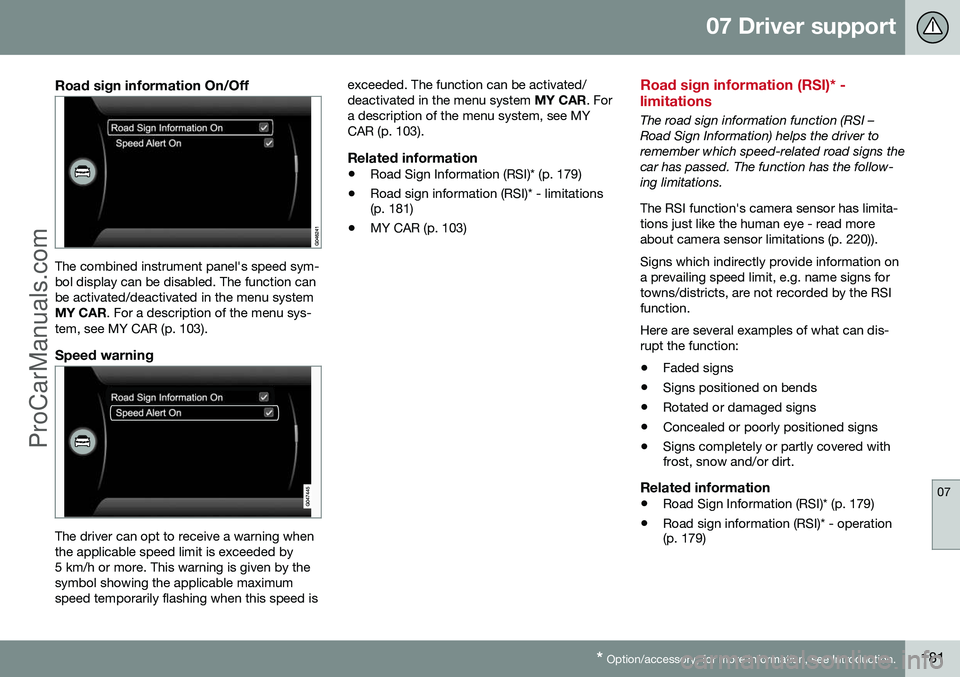
07 Driver support
07
* Option/accessory, for more information, see Introduction.181
Road sign information On/Off
The combined instrument panel's speed sym- bol display can be disabled. The function canbe activated/deactivated in the menu systemMY CAR . For a description of the menu sys-
tem, see MY CAR (p. 103).
Speed warning
The driver can opt to receive a warning when the applicable speed limit is exceeded by5 km/h or more. This warning is given by thesymbol showing the applicable maximumspeed temporarily flashing when this speed is exceeded. The function can be activated/deactivated in the menu system
MY CAR. For
a description of the menu system, see MYCAR (p. 103).
Related information
• Road Sign Information (RSI)* (p. 179)
• Road sign information (RSI)* - limitations (p. 181)
• MY CAR (p. 103)
Road sign information (RSI)* - limitations
The road sign information function (RSI – Road Sign Information) helps the driver toremember which speed-related road signs thecar has passed. The function has the follow-ing limitations. The RSI function's camera sensor has limita- tions just like the human eye - read moreabout camera sensor limitations (p. 220)). Signs which indirectly provide information on a prevailing speed limit, e.g. name signs fortowns/districts, are not recorded by the RSIfunction. Here are several examples of what can dis- rupt the function:
• Faded signs
• Signs positioned on bends
• Rotated or damaged signs
• Concealed or poorly positioned signs
• Signs completely or partly covered with frost, snow and/or dirt.
Related information
•
Road Sign Information (RSI)* (p. 179)
• Road sign information (RSI)* - operation(p. 179)
ProCarManuals.co’
Page 191 of 442
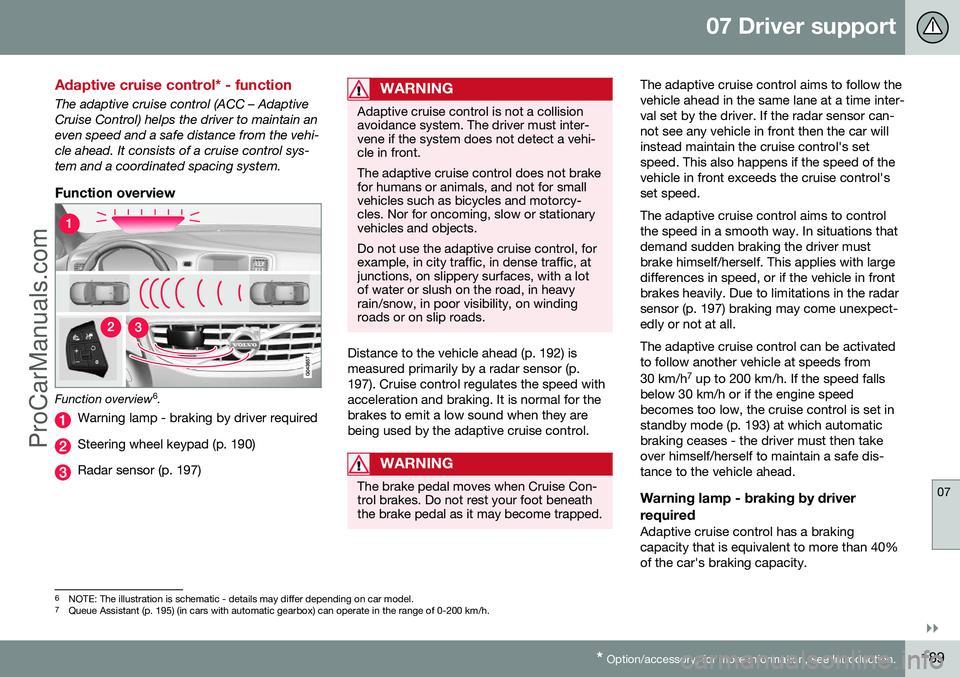
07 Driver support
07
}}
* Option/accessory, for more information, see Introduction.189
Adaptive cruise control* - function
The adaptive cruise control (ACC – Adaptive Cruise Control) helps the driver to maintain aneven speed and a safe distance from the vehi-cle ahead. It consists of a cruise control sys-tem and a coordinated spacing system.
Function overview
Function overview 6
.
Warning lamp - braking by driver required
Steering wheel keypad (p. 190)
Radar sensor (p. 197)
WARNING
Adaptive cruise control is not a collision avoidance system. The driver must inter-vene if the system does not detect a vehi-cle in front. The adaptive cruise control does not brake for humans or animals, and not for smallvehicles such as bicycles and motorcy-cles. Nor for oncoming, slow or stationaryvehicles and objects. Do not use the adaptive cruise control, for example, in city traffic, in dense traffic, atjunctions, on slippery surfaces, with a lotof water or slush on the road, in heavyrain/snow, in poor visibility, on windingroads or on slip roads.
Distance to the vehicle ahead (p. 192) is measured primarily by a radar sensor (p.197). Cruise control regulates the speed withacceleration and braking. It is normal for thebrakes to emit a low sound when they arebeing used by the adaptive cruise control.
WARNING
The brake pedal moves when Cruise Con- trol brakes. Do not rest your foot beneaththe brake pedal as it may become trapped.
The adaptive cruise control aims to follow the vehicle ahead in the same lane at a time inter-val set by the driver. If the radar sensor can-not see any vehicle in front then the car willinstead maintain the cruise control's setspeed. This also happens if the speed of thevehicle in front exceeds the cruise control'sset speed. The adaptive cruise control aims to control the speed in a smooth way. In situations thatdemand sudden braking the driver mustbrake himself/herself. This applies with largedifferences in speed, or if the vehicle in frontbrakes heavily. Due to limitations in the radarsensor (p. 197) braking may come unexpect-edly or not at all. The adaptive cruise control can be activated to follow another vehicle at speeds from 30 km/h 7
up to 200 km/h. If the speed falls
below 30 km/h or if the engine speed becomes too low, the cruise control is set instandby mode (p. 193) at which automaticbraking ceases - the driver must then takeover himself/herself to maintain a safe dis-tance to the vehicle ahead.
Warning lamp - braking by driver required
Adaptive cruise control has a braking capacity that is equivalent to more than 40%of the car's braking capacity.
6 NOTE: The illustration is schematic - details may differ depending on car model.
7 Queue Assistant (p. 195) (in cars with automatic gearbox) can operate in the range of 0-200 km/h.
ProCarManuals.co’
Page 192 of 442
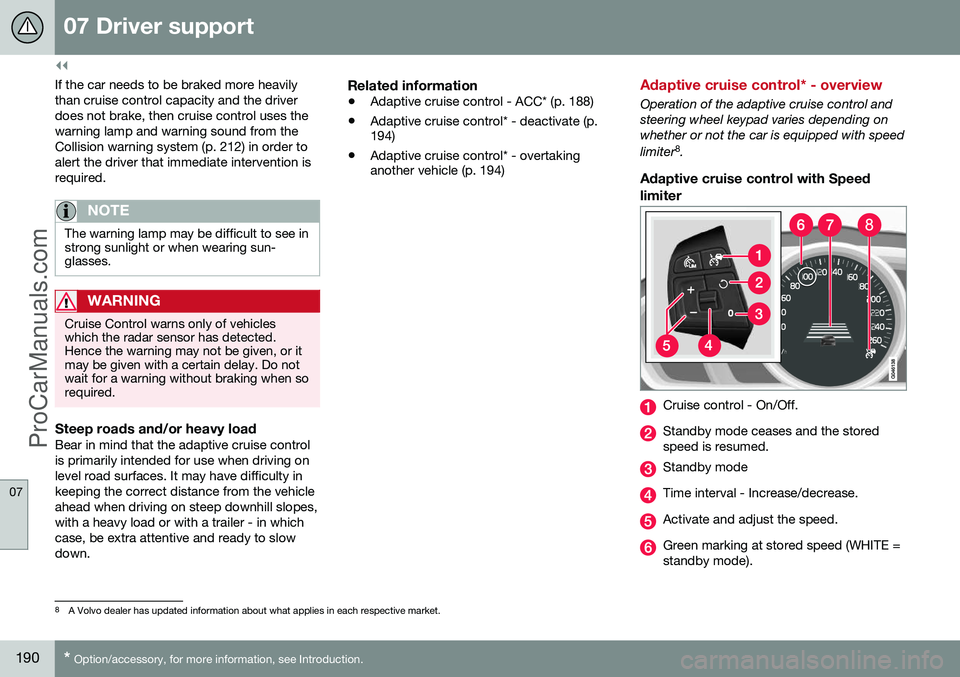
||
07 Driver support
07
190* Option/accessory, for more information, see Introduction.
If the car needs to be braked more heavily than cruise control capacity and the driverdoes not brake, then cruise control uses thewarning lamp and warning sound from theCollision warning system (p. 212) in order toalert the driver that immediate intervention isrequired.
NOTE
The warning lamp may be difficult to see in strong sunlight or when wearing sun-glasses.
WARNING
Cruise Control warns only of vehicles which the radar sensor has detected.Hence the warning may not be given, or itmay be given with a certain delay. Do notwait for a warning without braking when sorequired.
Steep roads and/or heavy loadBear in mind that the adaptive cruise control is primarily intended for use when driving onlevel road surfaces. It may have difficulty inkeeping the correct distance from the vehicleahead when driving on steep downhill slopes,with a heavy load or with a trailer - in whichcase, be extra attentive and ready to slowdown.
Related information
• Adaptive cruise control - ACC* (p. 188)
• Adaptive cruise control* - deactivate (p. 194)
• Adaptive cruise control* - overtakinganother vehicle (p. 194)
Adaptive cruise control* - overview
Operation of the adaptive cruise control and steering wheel keypad varies depending onwhether or not the car is equipped with speed limiter 8
.
Adaptive cruise control with Speed
limiter
Cruise control - On/Off.
Standby mode ceases and the stored speed is resumed.
Standby mode
Time interval - Increase/decrease.
Activate and adjust the speed.
Green marking at stored speed (WHITE = standby mode).
8 A Volvo dealer has updated information about what applies in each respective market.
ProCarManuals.co’
Page 196 of 442
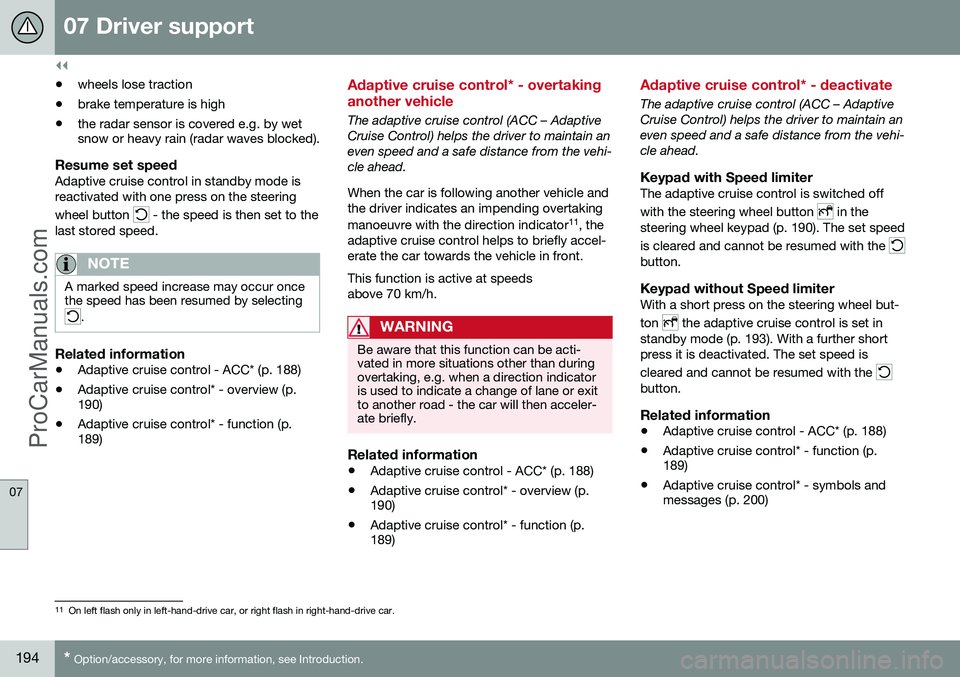
||
07 Driver support
07
194* Option/accessory, for more information, see Introduction.
• wheels lose traction
• brake temperature is high
• the radar sensor is covered e.g. by wet snow or heavy rain (radar waves blocked).
Resume set speedAdaptive cruise control in standby mode is reactivated with one press on the steering wheel button
- the speed is then set to the
last stored speed.
NOTE
A marked speed increase may occur once the speed has been resumed by selecting
.
Related information
• Adaptive cruise control - ACC* (p. 188)
• Adaptive cruise control* - overview (p. 190)
• Adaptive cruise control* - function (p.189)
Adaptive cruise control* - overtaking another vehicle
The adaptive cruise control (ACC – Adaptive Cruise Control) helps the driver to maintain aneven speed and a safe distance from the vehi-cle ahead. When the car is following another vehicle and the driver indicates an impending overtaking manoeuvre with the direction indicator 11
, the
adaptive cruise control helps to briefly accel- erate the car towards the vehicle in front. This function is active at speeds above 70 km/h.
WARNING
Be aware that this function can be acti- vated in more situations other than duringovertaking, e.g. when a direction indicatoris used to indicate a change of lane or exitto another road - the car will then acceler-ate briefly.
Related information
• Adaptive cruise control - ACC* (p. 188)
• Adaptive cruise control* - overview (p. 190)
• Adaptive cruise control* - function (p.189)
Adaptive cruise control* - deactivate
The adaptive cruise control (ACC – Adaptive Cruise Control) helps the driver to maintain aneven speed and a safe distance from the vehi-cle ahead.
Keypad with Speed limiterThe adaptive cruise control is switched off with the steering wheel button
in the
steering wheel keypad (p. 190). The set speed is cleared and cannot be resumed with the
button.
Keypad without Speed limiterWith a short press on the steering wheel but- ton
the adaptive cruise control is set in
standby mode (p. 193). With a further short press it is deactivated. The set speed is cleared and cannot be resumed with the
button.
Related information
• Adaptive cruise control - ACC* (p. 188)
• Adaptive cruise control* - function (p. 189)
• Adaptive cruise control* - symbols andmessages (p. 200)
11
On left flash only in left-hand-drive car, or right flash in right-hand-drive car.
ProCarManuals.co’
Page 199 of 442
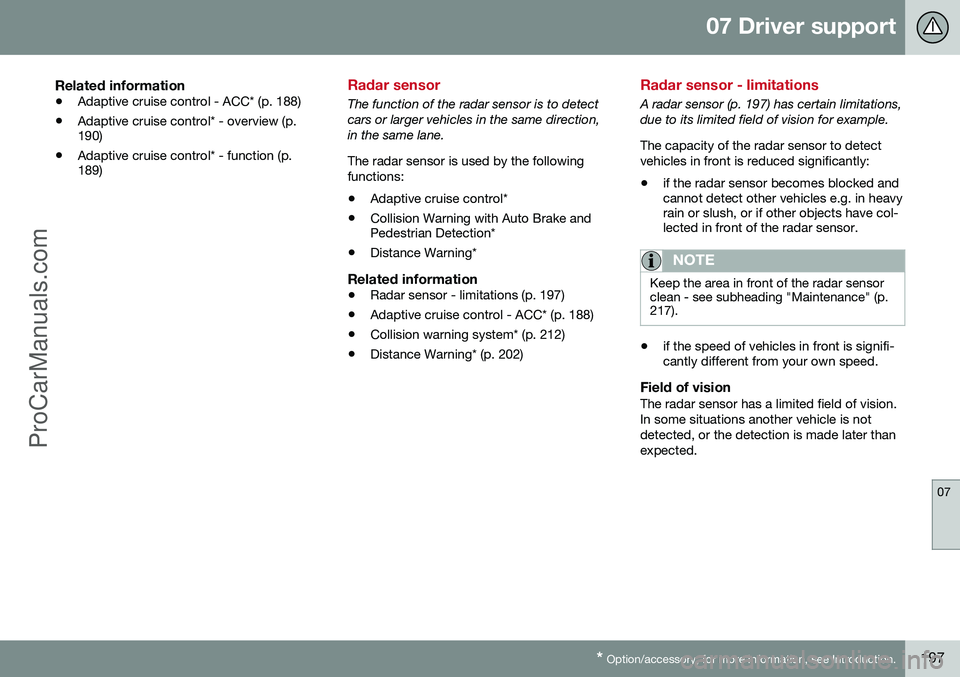
07 Driver support
07
* Option/accessory, for more information, see Introduction.197
Related information
• Adaptive cruise control - ACC* (p. 188)
• Adaptive cruise control* - overview (p. 190)
• Adaptive cruise control* - function (p.189)
Radar sensor
The function of the radar sensor is to detect cars or larger vehicles in the same direction,in the same lane. The radar sensor is used by the following functions: •Adaptive cruise control*
• Collision Warning with Auto Brake and Pedestrian Detection*
• Distance Warning*
Related information
• Radar sensor - limitations (p. 197)
• Adaptive cruise control - ACC* (p. 188)
• Collision warning system* (p. 212)
• Distance Warning* (p. 202)
Radar sensor - limitations
A radar sensor (p. 197) has certain limitations, due to its limited field of vision for example. The capacity of the radar sensor to detect vehicles in front is reduced significantly:
• if the radar sensor becomes blocked and cannot detect other vehicles e.g. in heavyrain or slush, or if other objects have col-lected in front of the radar sensor.
NOTE
Keep the area in front of the radar sensor clean - see subheading "Maintenance" (p.217).
• if the speed of vehicles in front is signifi- cantly different from your own speed.
Field of visionThe radar sensor has a limited field of vision. In some situations another vehicle is notdetected, or the detection is made later thanexpected.
ProCarManuals.co’
Page 200 of 442
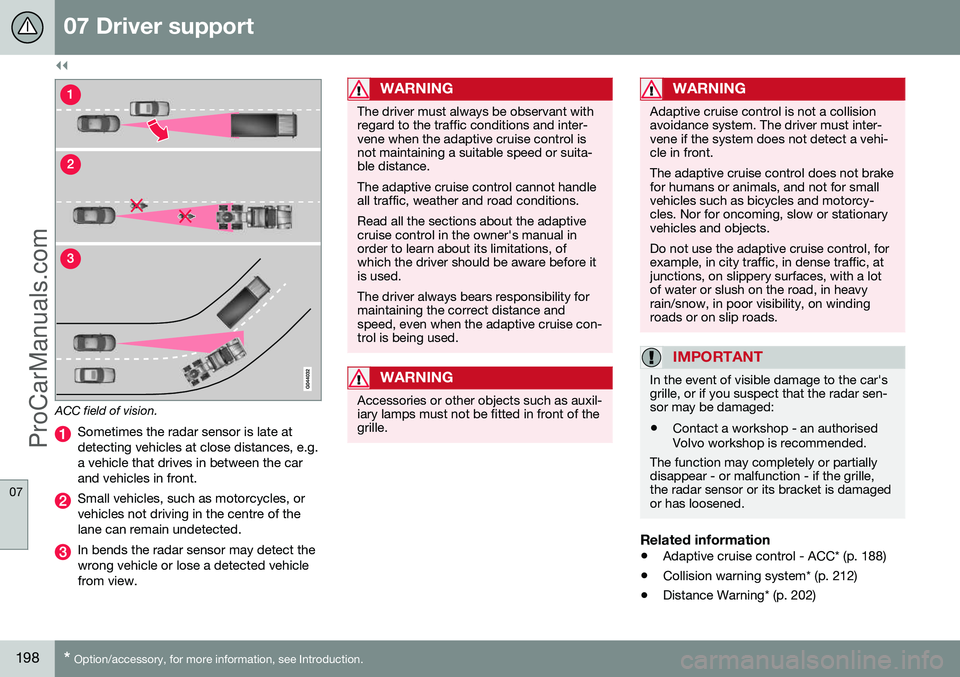
||
07 Driver support
07
198* Option/accessory, for more information, see Introduction.
ACC field of vision.
Sometimes the radar sensor is late at detecting vehicles at close distances, e.g.a vehicle that drives in between the carand vehicles in front.
Small vehicles, such as motorcycles, or vehicles not driving in the centre of thelane can remain undetected.
In bends the radar sensor may detect the wrong vehicle or lose a detected vehiclefrom view.
WARNING
The driver must always be observant with regard to the traffic conditions and inter-vene when the adaptive cruise control isnot maintaining a suitable speed or suita-ble distance. The adaptive cruise control cannot handle all traffic, weather and road conditions. Read all the sections about the adaptive cruise control in the owner's manual inorder to learn about its limitations, ofwhich the driver should be aware before itis used. The driver always bears responsibility for maintaining the correct distance andspeed, even when the adaptive cruise con-trol is being used.
WARNING
Accessories or other objects such as auxil- iary lamps must not be fitted in front of thegrille.
WARNING
Adaptive cruise control is not a collision avoidance system. The driver must inter-vene if the system does not detect a vehi-cle in front. The adaptive cruise control does not brake for humans or animals, and not for smallvehicles such as bicycles and motorcy-cles. Nor for oncoming, slow or stationaryvehicles and objects. Do not use the adaptive cruise control, for example, in city traffic, in dense traffic, atjunctions, on slippery surfaces, with a lotof water or slush on the road, in heavyrain/snow, in poor visibility, on windingroads or on slip roads.
IMPORTANT
In the event of visible damage to the car's grille, or if you suspect that the radar sen-sor may be damaged:
• Contact a workshop - an authorised Volvo workshop is recommended.
The function may completely or partially disappear - or malfunction - if the grille,the radar sensor or its bracket is damagedor has loosened.
Related information
• Adaptive cruise control - ACC* (p. 188)
• Collision warning system* (p. 212)
• Distance Warning* (p. 202)
ProCarManuals.co’
Page 201 of 442
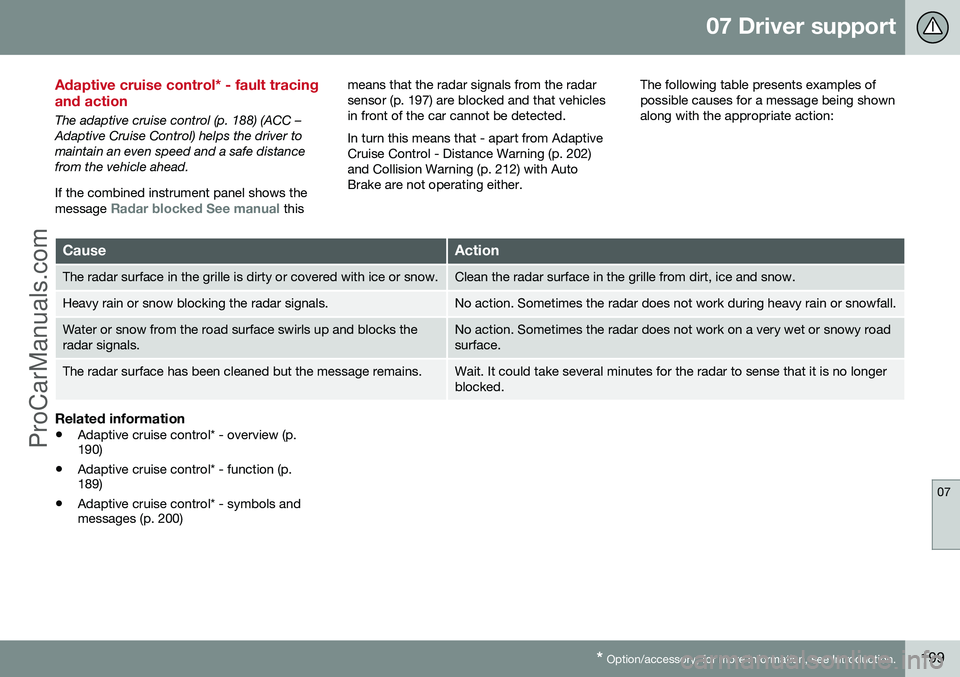
07 Driver support
07
* Option/accessory, for more information, see Introduction.199
Adaptive cruise control* - fault tracing and action
The adaptive cruise control (p. 188) (ACC – Adaptive Cruise Control) helps the driver tomaintain an even speed and a safe distancefrom the vehicle ahead. If the combined instrument panel shows the message
Radar blocked See manual this means that the radar signals from the radar sensor (p. 197) are blocked and that vehiclesin front of the car cannot be detected. In turn this means that - apart from Adaptive Cruise Control - Distance Warning (p. 202)and Collision Warning (p. 212) with AutoBrake are not operating either.
The following table presents examples ofpossible causes for a message being shownalong with the appropriate action:
CauseAction
The radar surface in the grille is dirty or covered with ice or snow.Clean the radar surface in the grille from dirt, ice and snow.
Heavy rain or snow blocking the radar signals.No action. Sometimes the radar does not work during heavy rain or snowfall.
Water or snow from the road surface swirls up and blocks the radar signals.No action. Sometimes the radar does not work on a very wet or snowy road surface.
The radar surface has been cleaned but the message remains.Wait. It could take several minutes for the radar to sense that it is no longer blocked.
Related information
•
Adaptive cruise control* - overview (p. 190)
• Adaptive cruise control* - function (p.189)
• Adaptive cruise control* - symbols andmessages (p. 200)
ProCarManuals.co’
Page 202 of 442
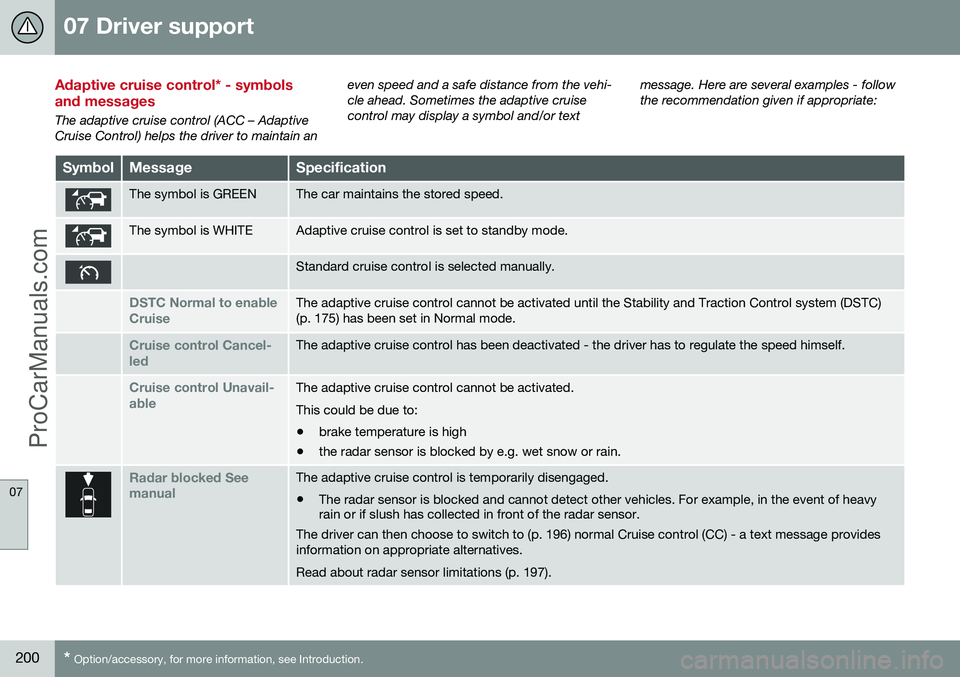
07 Driver support
07
200* Option/accessory, for more information, see Introduction.
Adaptive cruise control* - symbols and messages
The adaptive cruise control (ACC – Adaptive Cruise Control) helps the driver to maintain an even speed and a safe distance from the vehi-cle ahead. Sometimes the adaptive cruisecontrol may display a symbol and/or text
message. Here are several examples - followthe recommendation given if appropriate:
SymbolMessageSpecification
The symbol is GREENThe car maintains the stored speed.
The symbol is WHITEAdaptive cruise control is set to standby mode.
Standard cruise control is selected manually.
DSTC Normal to enable CruiseThe adaptive cruise control cannot be activated until the Stability and Traction Control system (DSTC) (p. 175) has been set in Normal mode.
Cruise control Cancel- ledThe adaptive cruise control has been deactivated - the driver has to regulate the speed himself.
Cruise control Unavail- ableThe adaptive cruise control cannot be activated. This could be due to:
• brake temperature is high
• the radar sensor is blocked by e.g. wet snow or rain.
Radar blocked See manualThe adaptive cruise control is temporarily disengaged.
• The radar sensor is blocked and cannot detect other vehicles. For example, in the event of heavy rain or if slush has collected in front of the radar sensor.
The driver can then choose to switch to (p. 196) normal Cruise control (CC) - a text message provides information on appropriate alternatives. Read about radar sensor limitations (p. 197).
ProCarManuals.co’
Page 205 of 442
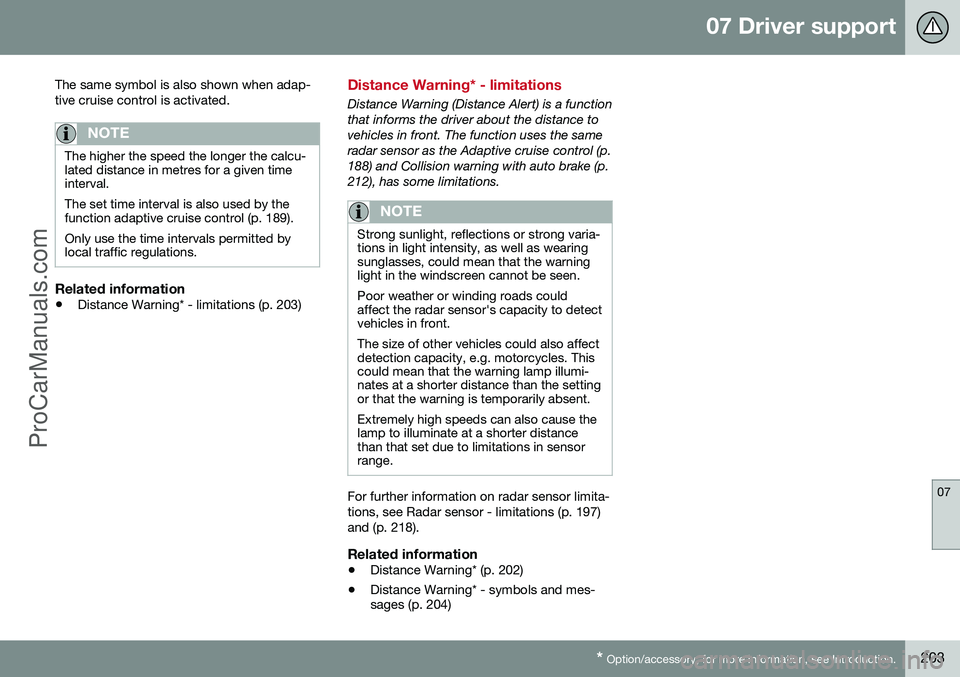
07 Driver support
07
* Option/accessory, for more information, see Introduction.203
The same symbol is also shown when adap- tive cruise control is activated.
NOTE
The higher the speed the longer the calcu- lated distance in metres for a given timeinterval. The set time interval is also used by the function adaptive cruise control (p. 189). Only use the time intervals permitted by local traffic regulations.
Related information
•
Distance Warning* - limitations (p. 203)
Distance Warning* - limitations
Distance Warning (Distance Alert) is a function that informs the driver about the distance tovehicles in front. The function uses the sameradar sensor as the Adaptive cruise control (p.188) and Collision warning with auto brake (p.212), has some limitations.
NOTE
Strong sunlight, reflections or strong varia- tions in light intensity, as well as wearingsunglasses, could mean that the warninglight in the windscreen cannot be seen. Poor weather or winding roads could affect the radar sensor's capacity to detectvehicles in front. The size of other vehicles could also affect detection capacity, e.g. motorcycles. Thiscould mean that the warning lamp illumi-nates at a shorter distance than the settingor that the warning is temporarily absent. Extremely high speeds can also cause the lamp to illuminate at a shorter distancethan that set due to limitations in sensorrange.
For further information on radar sensor limita- tions, see Radar sensor - limitations (p. 197)and (p. 218).
Related information
•Distance Warning* (p. 202)
• Distance Warning* - symbols and mes- sages (p. 204)
ProCarManuals.co’
Page 206 of 442
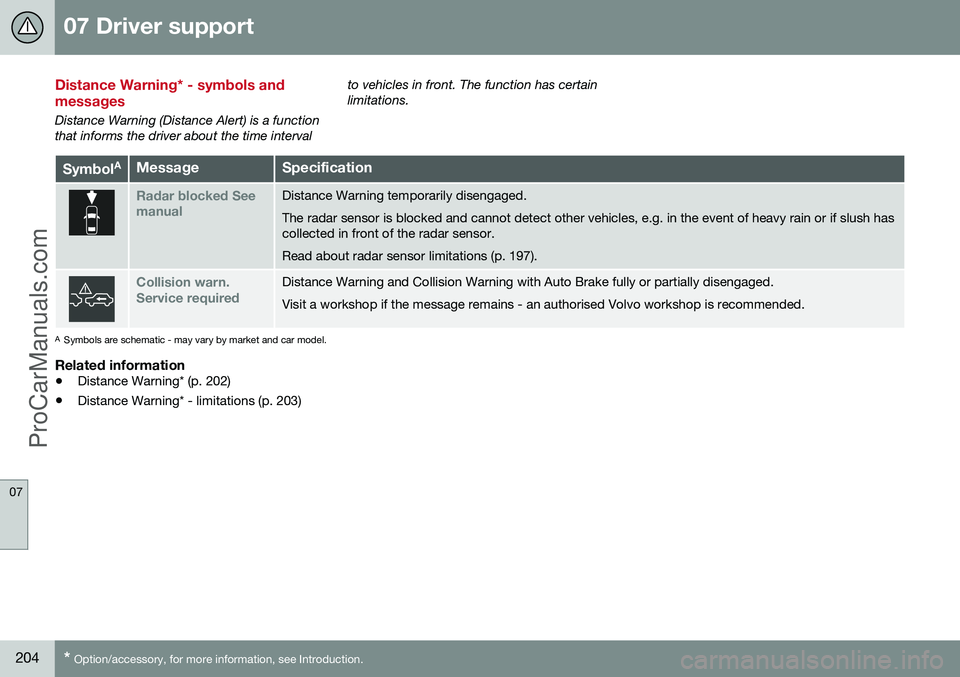
07 Driver support
07
204* Option/accessory, for more information, see Introduction.
Distance Warning* - symbols and messages
Distance Warning (Distance Alert) is a function that informs the driver about the time interval to vehicles in front. The function has certainlimitations.
Symbol
AMessageSpecification
Radar blocked See manualDistance Warning temporarily disengaged. The radar sensor is blocked and cannot detect other vehicles, e.g. in the event of heavy rain or if slush has collected in front of the radar sensor. Read about radar sensor limitations (p. 197).
Collision warn. Service requiredDistance Warning and Collision Warning with Auto Brake fully or partially disengaged. Visit a workshop if the message remains - an authorised Volvo workshop is recommended.
A
Symbols are schematic - may vary by market and car model.
Related information
• Distance Warning* (p. 202)
• Distance Warning* - limitations (p. 203)
ProCarManuals.co’